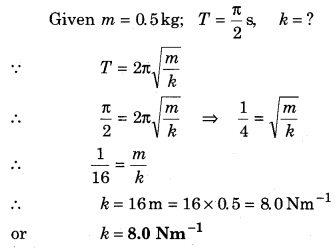Rajasthan Board RBSE Class 11 Physics Chapter 8 Oscillatory Motion
RBSE Class 11 Physics Chapter 8 Textbook Exercises With Solutions
RBSE Class 11 Physics Chapter 8 Very Short Answer Type Questions
Question 1.
For a simple harmonic motion what is the relationship between acceleration and displacement?
Answer:
For a simple harmonic motion, acceleration is directly proportional to the displacement of the object from its mean position and always points towards the mean position (f = -ω2y).
Question 2.
What will be the initial phase angle of a body starting its simple harmonic motion from the extreme end?
Answer:
The time taken by the body starting its simple harmonic motion from the extreme end to the mean position is T/4 and accordingly the phase angle is π/2. Hence, the initial phase angle is π/2.
Question 3.
In simple harmonic motion the value of displacement is how much phase angles ahead of its acceleration value?
Answer:
In a simple harmonic motion, the displacement and acceleration are in the opposite direction, displacement is ahead of acceleration by a phase angle π.
Question 4.
In simple harmonic motion which physical quantity is conserved?
Answer:
Total mechanical energy is conserved in simple harmonic motion.
Question 5.
What is the relation between oscillating frequency and total energy of a simple pendulum?
Answer:
For a simple pendulum
Etotal = \(\frac { 1 }{ 2 } \) mω2 a2 = \(\frac { 1 }{ 2 } \) m(2πn)2 a2
= \(\frac { 1 }{ 2 } \) m 4π2 n2 a2
= 2π2 mn2 a2
Here, Etotal = total energy
m = mass of the pendulum (bob)
ω = angular frequency = 2πn = 2π/T
n = linear frequency
a = amplitude.
Question 6.
What will be the value of the total mechanical energy of a body of mass 0.1 kg having amplitude 3 cm and time period 2 s?
Answer:
Given, m= 0.1 kg, a = 3 cm = 3 × 10-2 m = 0.03 m
T = 2s Etotal = ?
∴ From the formula of total mechanical energy
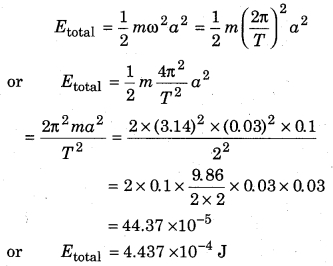
Question 7.
What will be the effect on time period on using soft spring of same length instead of hard spring?
Answer:
The relation between the time period and the spring constant of an oscillating body is

k = spring constant
The spring constant for a softer spring is less than that for a harder one.
i.e., Ksoft < Khard
Hence from the above equation
Tsoft > Thard
i. e, the time period will increase.
Question 8.
What will be the value of the time period of a simple pendulum if the amplitude is reduced to half of its original value?
Answer:
Formula for the time period of a simple pendulum,

In this expression, there is no term ‘a’, hence the time period is independent of the amplitude of oscillation. Thus, the time period remains unaffected.
Question 9.
In simple harmonic motion what is the phase difference between displacement and acceleration?
Answer:
The phase difference between displacement and acceleration is π or 180°.
Question 10.
What will be the time period of a particle executing simple harmonic motion whose acceleration is α = –[latex]\frac { p }{ q } [/latex] x?
Answer:
∵ Given, a = –[latex]\frac { p }{ q } [/latex] x
In S.H.M., a = -ω2 y
∴ Comparing the two equations we get
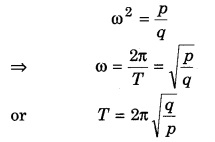
Question 11.
The total energy of a simple pendulum is E. How much will be the kinetic energy and potential energy of a pendulum at an instant when the displacement is half the amplitude?
Answer:
Total energy of a simple pendulum
E = \(\frac { 1 }{ 2 } \) mω2 a2
Potential energy for simple pendulum
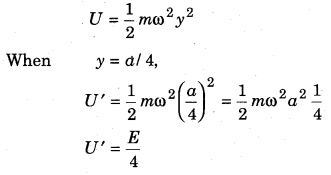
and kinetic energy = total energy – potential energy

Question 12.
Write the value of restoring force in a simple pendulum when the displacement angle is less than θ.
Answer:
Restoring force F = -mgsin θ
∵ θ is very less, hence sinθ = θ
∴ Restoring force, F = mgθ
RBSE Class 11 Physics Chapter 8 Short Answer Type Questions
Question 1.
Prove that the projection of a uniform circular motion is simple harmonic motion.
Answer:
The special form of simple oscillatory motion which is most simple is known as Simple Harmonic Motion. In this motion the body moves in a simple line on both the sides of its mean position. The definition of simple harmonic motion, “Simple harmonic motion is the projection on the diameter of a circle of the same motion as on the circumference of that circle.”
Suppose, as shown in (fig. 8.2) a particle of mass m is moving with angular speed ω0 on the circumference of a circle of radius ‘a’ and center O. At any instant, when the particle is at point P, then the perpendicular drawn from the position of the particle to the diameter YY’ has its foot at point M. When the particle doing circular motion is at point X, then the foot point M of the perpendicular is moving along the diameter YY’ and is at point O. When the particle is at point Y then the foot point M also reaches at Y point. When particle is at X’ point then the foot point of perpendicular again comes back to O.
The particle reaching Y’ point the foot point of the perpendicular is also at Y’ and after completing one cycle when the particle is at point X then the foot point of the perpendicular also moves from Y’ to O. It is clear that when any particle moving on a circular path completes one cycle then foot point M of the perpendicular, moves in a simple line to and fro of the center O of the circle. This is the simple harmonic motion of point M. Therefore, projection of. the foot point of a perpendicular in uniform circular motion is simple harmonic motion.
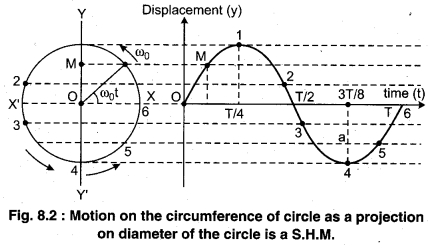
Question 2.
Write the characteristics and equation of S.H.M.
Answer:
Characteristics of Simple Harmonic Motion :
Simple harmonic motion is given as F = -ky and in this;
(i) Motion is always in a simple straight line and to and fro of a definite point.
(ii) The direction of acceleration of the moving objects always directed towards the equilibrium state.
(iii) In every position of oscillation the acceleration of the particle is directly proportional to the displacement of the object from its equilibrium state.
Equation of Simple Harmonic Motion :
Suppose any particle oscillates to and fro motion about its equilibrium position. Assuming that at any instant the displacement of the particle is y

If m is the mass of the particle, then working restoring force on the particle F = -ky

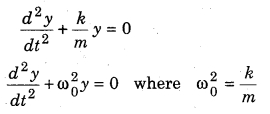
Eq. (S.H.M) is called the equation for linear simple harmonic motion.
The solution of Eq. (8.4) is represented as follows:
y = α sin (ω0t + Φ)
where α = amplitude and (ω0t + Φ) is the phase angle.
To show that the above equation is the solution of Eq. (S.H.M); we differentiate the equation.
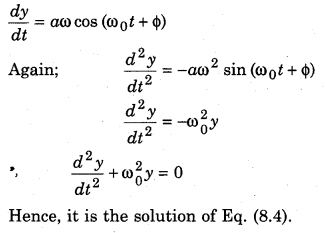
Question 3.
Graphically represent the displacement, velocity and acceleration for a time period of one cycle.
Answer:
(i) Displacement in SHM
The displacement of any particle at any instant in linear S.H.M can be represented as
y = α sin ω0t
where α = amplitude
and ω0 = angular frequency.
Therefore y = α sin \(\frac { 2\pi }{ t } \) t
Putting different values of t in Eq. (8.6), we can calculate different values of y and get the graphical representation between time and displacement.
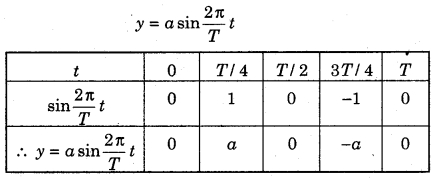
The graphical representation of time and displacement from the above values is shown below in Diagram (8.3).
If instantaneous displacement is
y = α sin (ω0t ± Φ)
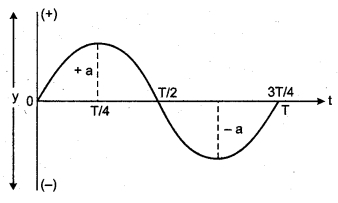
Question 4.
Prove that in a parabolic potential well the particle executes S.H.M.
Answer:
Potential energy of a particle in S.H.M. is
![]()
If potential energy νs displacement graph is plotted, the curve obtained is a parabola as shown in the figure :
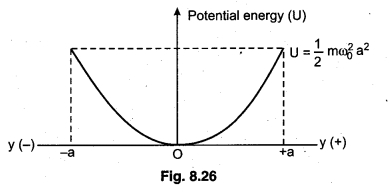
Hence, for a parabolic potential well the particle exhibits S.H.M. This may be proved as follows :
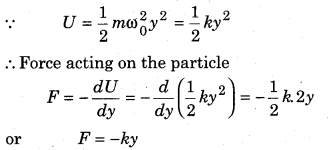
It is clear that F ∝ – y, Which holds for S.H.M. Hence, in a parabolic potential well particle executes S.H.M.
Question 5.
Explain the conservation of energy for oscillation of a body hanged with spring.
Answer:
Oscillation of a body hanging from the spring executes simple harmonic motion.
Total Energy of a Simple Harmonic Oscillator :
The total energy of a simple harmonic oscillator is provided by the sum of instantaneous potential energy and instantaneous kinetic energy.
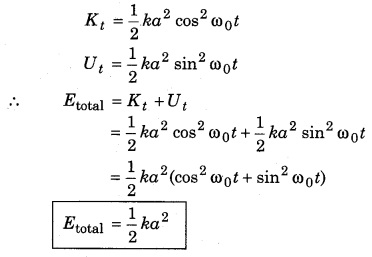
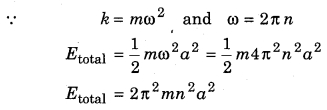
Question 6.
Write the formula for time period of simple pendulum. On what factors it depends?
Answer:
An ideal simple pendulum is that which has the following properties :
(i) Point mass : The mass of the bob of the simple pendulum should be centered at one point. It is only possible if its shape is zero. Shapeless mass is called point mass. Point mass is imaginary.
(ii) The string through which the point mass is suspended should be weightless and it should not be extended by the pendulums weight.
(iii) Rigid Base : The base from which it is hanged should be rigid.
(iv) Frictionless : The external and internal frictions will be zero for its various parts.
Here, we discuss an ideal simple pendulum and its nature.
According to the figure (8.13) a small ball of heavy metal meaning bob is hanged from a thin string. Point O (centre of gravity center of the bob) and point A are the point of oscillation and point of suspension respectively. The distance between these two points is called the working length.
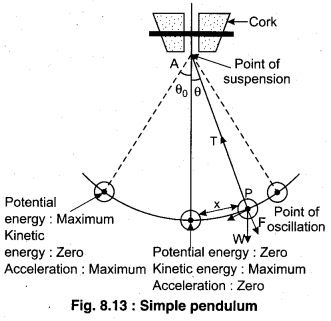
Question 7.
How does the spring constant varies when small and same springs are connected in : (a) series (b) parallel.
Answer:
(i) The force constant is obtained as follows if joined in series.
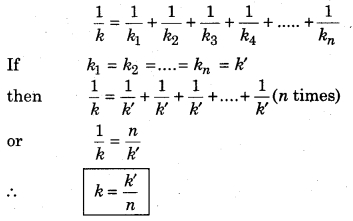
(ii) Force constant if joined in parallel.
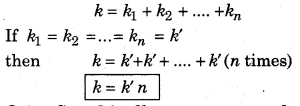
Question 8.
Graphically represent the average kinetic energy or potential energy per oscillation.
Answer:
The graphical representation of a simple harmonic oscillator with kinetic energy K, potential energy U and total energy Etotal with the change in displacement y is as shown in the figure (8.11.) It is clear that displacement-potential energy curve is parabola.
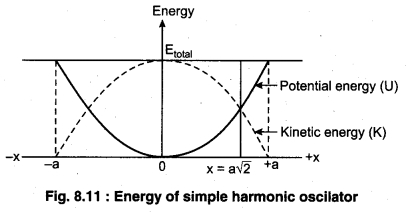
Question .9.
For a simple pendulum why is a spherical bob chosen.
Answer:
A spherical bob is chosen for a simple pendulum for the following reasons :
- For a given value of density, the spherical shape has minimum volume.
- The air friction is minimum due to spherical shape.
Question 10.
While crossing a bridge the soldiers stepping together are asked not to put their steps together. Why?
Answer:
While crossing the bridge, due to soldiers stepping together, the bridge is set into forced vibrations. If by chance the frequency of forced vibration of bridge becomes equal to the natural frequency of the bridge, a resonance will occur. The amplitude of vibration will become very high and there is a high probability that the bridge will break.
Question 11.
What do you understand by damped oscillations?
Answer:
If there is only restoring force acting on a vibrating object for example simple pendulum or tuning fork then that object can vibrate till infinity. This type of vibration or oscillation is called ‘free oscillation’ and this type of vibration is called ‘free vibration’. Its frequency is called ‘Natural Frequency’. There is only restoring force working in free vibration. Its amplitude and energy both are constant with time as shown in figure (8.20).
RBSE Class 11 Physics Chapter 8 Long Answer Type Questions
Question 1.
Differentiate between periodic motion and simple harmonic motion. Give the characteristics of simple harmonic motion. Write down the differential equation with example.
Answer:
Periodic motion : Any motion that repeats itself after regular intervals of time is known as a periodic motion. For example motion of planets around the sun, motion of hands of a clock.
Simple harmonic motion : The to and fro motion about a definite point and of a definite time period along a straight line is called simple harmonic motion. For example, oscillation of a simple pendulum of small amplitude.
Simple harmonic motion is given as F = -ky and in this;
(i) Motion is always in a simple straight line and to and fro of a definite point.
(ii) The direction of acceleration of the moving objects always directed towards the equilibrium state.
(iii) In every position of oscillation the acceleration of the particle is directly proportional to the displacement of the object from its equilibrium state.
Equation of Simple Harmonic Motion :
Suppose any particle oscillates to and fro motion about its equilibrium position. Assuming that at any instant the displacement of the particle is y

If m is the mass of the particle, then working restoring force on the particle F = -ky


Eq. (S.H.M) is called the equation for linear simple harmonic motion.
The solution of Eq. (8.4) is represented as follows:
y = α sin (ω0t + Φ)
where α = amplitude and (ω0t + Φ) is the phase angle.
To show that the above equation is the solution of Eq. (S.H.M); we differentiate the equation.

Question 2.
Prove that the foot of the perpendicular of a particle revolving with angular velocity ω0 in a circular path of radius a executes simple harmonic motion. Write the equation for this motion.
Answer:
The special form of simple oscillatory motion which is most simple is known as Simple Harmonic Motion. In this motion the body moves in a simple line on both the sides of its mean position. The definition of simple harmonic motion, “Simple harmonic motion is the projection on the diameter of a circle of the same motion as on the circumference of that circle.”
Suppose, as shown in (fig. 8.2) a particle of mass m is moving with angular speed ω0 on the circumference of a circle of radius ‘a’ and center O. At any instant, when the particle is at point P, then the perpendicular drawn from the position of the particle to the diameter YY’ has its foot at point M. When the particle doing circular motion is at point X, then the foot point M of the perpendicular is moving along the diameter YY’ and is at point O. When the particle is at point Y then the foot point M also reaches at Y point. When particle is at X’ point then the foot point of perpendicular again comes back to O.
The particle reaching Y’ point the foot point of the perpendicular is also at Y’ and after completing one cycle when the particle is at point X then the foot point of the perpendicular also moves from Y’ to O. It is clear that when any particle moving on a circular path completes one cycle then foot point M of the perpendicular, moves in a simple line to and fro of the center O of the circle. This is the simple harmonic motion of point M. Therefore, projection of. the foot point of a perpendicular in uniform circular motion is simple harmonic motion.
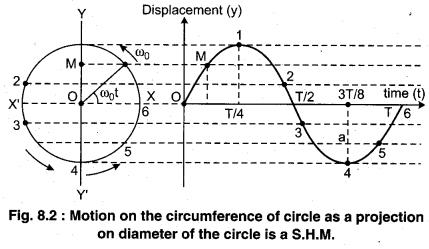
Point M moving from O to Y, Y to Y’ and Y’ to O is called one complete vibration.
We know that in circular motion the centrifugal force on the particle (mω20α in magnitude) is as always towards the center of the circle. Hence, the force acting on the point P of the particle will be in the direction of OP. The component of force in YY’ direction will be (mω20 α sinω0t)
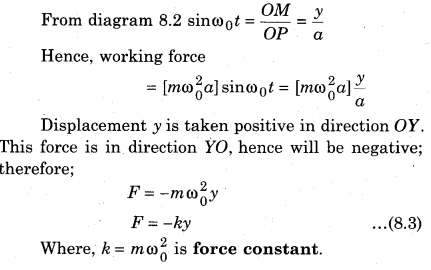
It is clear from fig. (8.3) that mass of the particle m, angular velocity ω0 are constant then as a result force is directly proportional to displacement y, and its direction is opposite to displacement y. Hence, force F is called Restoring Force.
Hence, Simple ha monic motion is that imaginary or oscillating motion of an object to and fro its mean position in which the restoring force is;
(i) directly proportional to the displacement of the object from its mean position.
(ii) always points (moving) towards the mean position.
Question 3.
Establish the expressions for potential energy, kinetic energy and total energy and prove conservation of the mechanical energy of a particle in S.H.M.
Answer:
(i) Kinetic Energy of a Simple Harmonic Oscillator :
The displacement is represented as y = αsinω0t and velocity ν = αω0 cosω0t under effect of restoring force F = -ky on the particle which starts its simple harmonic motion from the mean position. Hence, kinetic energy of the particle;
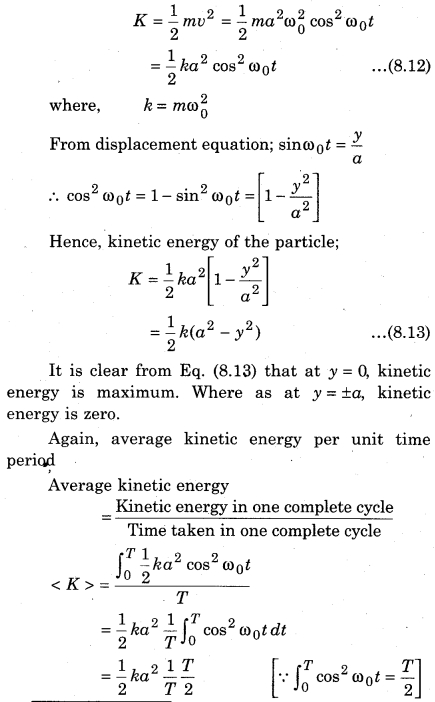

(ii) Potential Energy of a Simple Harmonic Oscillator :
In simple harmonic motion; when the particle is displaced then the potential energy is obtained in the form of negative value of the work done opposite to the restoring force F = -ky. Hence, increase in the potential energy of the particle;
∆U = -F dy
Hence, potential energy in displacing the particle to a distance y from the mean position is;

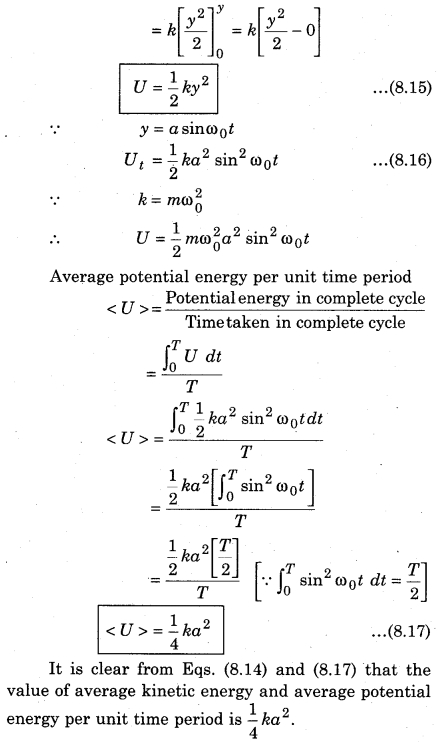
(iii) Total Energy of a Simple Harmonic Oscillator :
The total energy of a simple harmonic oscillator is provided by the sum of instantaneous potential energy and instantaneous kinetic energy.
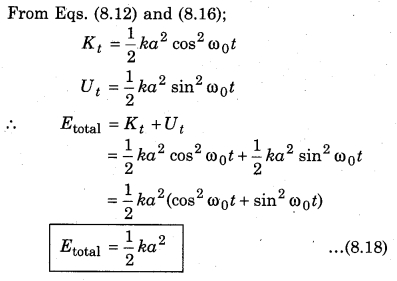
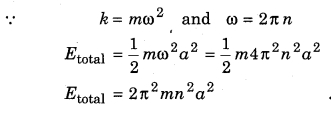
In simple harmonic motion the total energy of the particle is directly proportional to the square of the amplitude and square of frequency.
Again total energy = instantaneous kinetic energy + instantaneous potential energy

It is clear that the total energy of a simple harmonic oscillator is constant with respect to time and position of the particle. This is the law of conservation of mechanical energy of the oscillator.
Question 4.
Graphically represent the average kinetic energy per oscillation, potential energy per oscillation and also find out average kinetic energy and average potential energy per oscillation of simple harmonic motion.
Answer:
The graphical representation of a simple harmonic oscillator with kinetic energy K, potential energy U and total energy Etotal with the change in displacement y is as shown in the figure (8.11.) It is clear that displacement-potential energy curve is parabola.
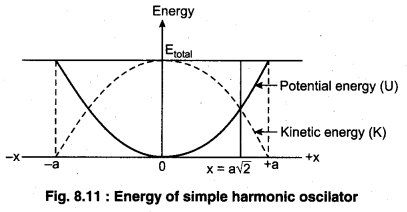
Again by studying Graph 8.11 it is a clear that during motion the sum of potential and kinetic energy is total energy and it is uniform. If at any displacement y the value of kinetic energy is equal to the potential energy then;
Kinetic energy = Potential energy
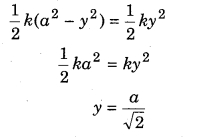
![]()
where kinetic energy and potential energy are same.
Where as, total energy is not uniform due to the frictional forces. Generally, the total energy of the particle reduces slowly as a result of which the amplitude also decreases.
Question 5.
What is simple pendulum? For small displacement explain its motion. Calculate the formula for time period. On what quantities does it depend on?
Answer:
An ideal simple pendulum is that which has the following properties :
(i) Point mass : The mass of the bob of the simple pendulum should be centered at one point. It is only possible if its shape is zero. Shapeless mass is called point mass. Point mass is imaginary.
(ii) The string through which the point mass is suspended should be weightless and it should not be extended by the pendulums weight.
(iii) Rigid Base : The base from which it is hanged should be rigid.
(iv) Frictionless : The external and internal frictions will be zero for its various parts.
Here, we discuss an ideal simple pendulum and its nature.
According to the figure (8.13) a small ball of heavy metal meaning bob is hanged from a thin string. Point O (centre of gravity center of the bob) and point A are the point of oscillation and point of suspension respectively. The distance between these two points is called the working length.
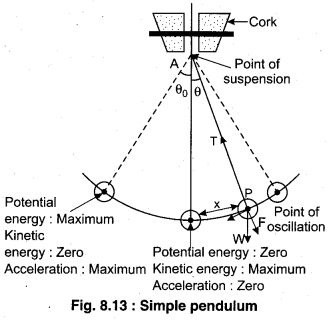
Bob is pulled slightly towards right and then left, it starts oscillating.
Generally, due to loss of energy against the frictional forces, the amplitude reduces slowly.
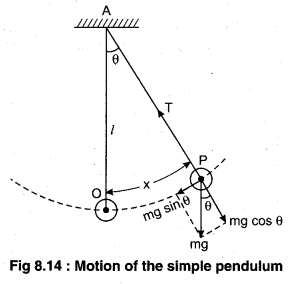
Question 6.
What is the difference between the series and parallel combination of springs? Calculate the value of effective spring constant for every combination.
Answer:
(a) Series Combination
As shown in Fig. 8.15 spring S1 and S2 are joined in series. A mass hanging from the combination is stretched y distance downwards and left, then the working force on both the springs is same; where as the increase in lengths is y1 and y2 respectively (suppose) are different. The restoring force for spring Si in this combination is;
F1 = -K1 y1
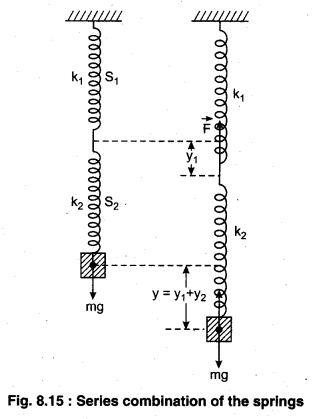
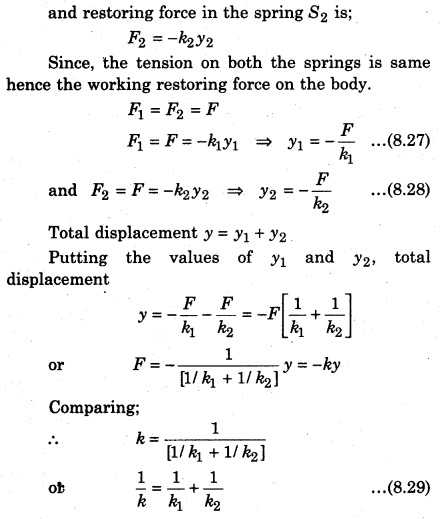
where, k is the effective spring constant of combination. If n springs of spring constant k1 = k2 = k3 =….= k’ are joined in series, then k will be the effective spring constant of combination.
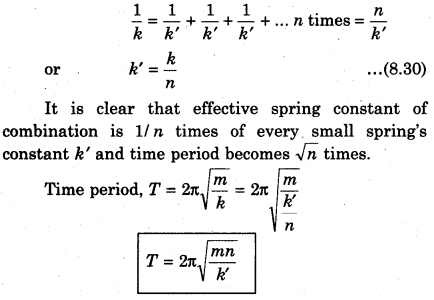
(b) Parallel Combination
Two springs having spring constant k1 and k2 are combined in parallel from same base and mass m is hanged from the free end of the springs together. The weight is given y displacement from the equilibrium position, then both springs are extended equally in length; where as the restoring force on both the springs is different.
Hence the restoring force working on both the springs is;
F1 = -k1y
and F2 = -k2 y respectively;
The effective restoring force on the combination in this position is;
F = F1 + F2
– ky = -k1y – k2y
and effective spring constant k = k1 + k2
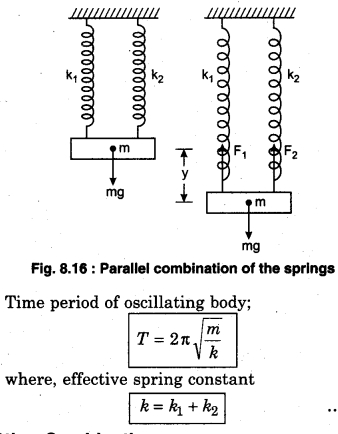
Question 7.
Explain free, damped and forced oscillations with examples. Define resonance.
Answer:
Damped Oscillation :
If there is only restoring force acting on a vibrating object for example simple pendulum or tuning fork then that object can vibrate till infinity. This type of vibration or oscillation is called ‘free oscillation’ and this type of vibration is called ‘free vibration’. Its frequency is called ‘Natural Frequency’. There is only restoring force working in free vibration. Its amplitude and energy both are constant with time as shown in figure (8.20).
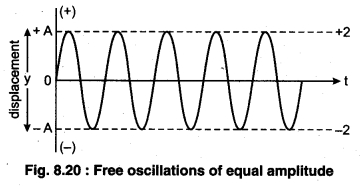
Forced Vibrations :
We have noticed that when the motor of flour mill, or motor of well is started then the objects closer to it like windows, doors also vibrate. This is called forced vibrations.
According to fig. 8.22 if four simple pendulums A, B, C and D are hanged and out of these pendulum A is vibrated; then we will notice that B, C and D also vibrate with the frequency of A Vibrations of B, C and D are called forced vibrations.
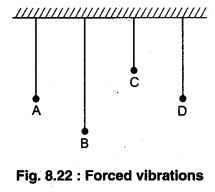
Resonance :
In forced oscillations when the frequency of the external periodic forcé exerted on an oscillator is equal to the natural frequency of the oscillator then in this condition the amplitude of the forced oscillations becomes very high. This special state of forced oscillations is called resonance. In this condition maximum energy is transferred from the driver to the driven due to which the amplitude of oscillations of the driven increases greatly.
Examples of Resonance:
(i) When a vibrating tuning fork is placed in a hollow box which contains air, then when the natural frequency of air is equal to the tuning fork’s frequency, a very intense sound is heard.
(ii) While crossing a bridge a group of soldiers do not put their foots together.
(iii) During earthquake the natural frequency of the buildings becomes equal to the frequency of the Earth’s vibrations Hence they start vibrating and collapse.
(iv) We hear the radio broadcasting programs by tuning our radio transistors.
(v) While crossing a bridge or tunnel the driver does not blow the whistle of the train.
RBSE Class 11 Physics Chapter 8 Numerical Questions
Question 1.
A body executes simple harmonic motion according to the following equation;

where t = 1.5 s, calculate (i) displacement (ii) velocity (iii) acceleration.
Solution:
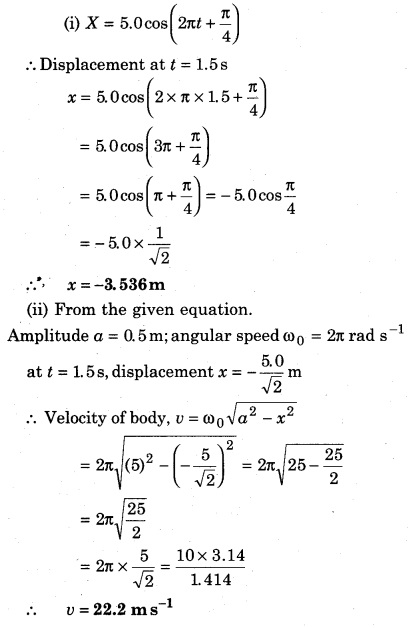
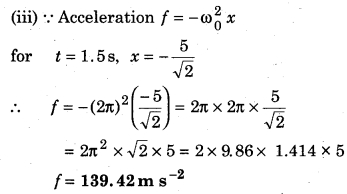
Question 2.
The time period of body executing simple harmonic motion is 2 s. After starting from t = 0 time after how much time its displacement will be equal to the amplitude?
Solution:
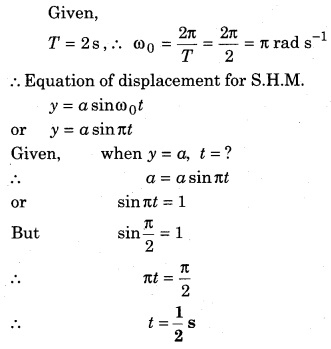
Question 3.
A particle performing simple harmonic motion has maximum velocity 8 cm/s and has acceleration 16 cm/s2 at a distance of 4 cm from the mean position. Calculate the time period and amplitude.
Solution:
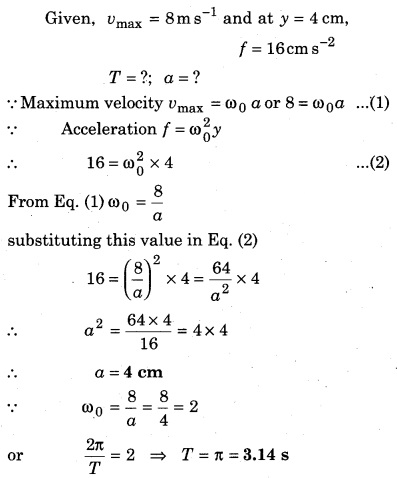
Question 4.
The velocities of a particle executing S.H.M. are 10 cm/s and 8 cm/s at displacements 4 cm and 5 cm form mean position respectively. Calculate the time period of the particle.
Solution:
Given when y1 = 4 cm, v – 10 cm-1;
and when y2 = 5cm, v = 8cm s-1
T = ?
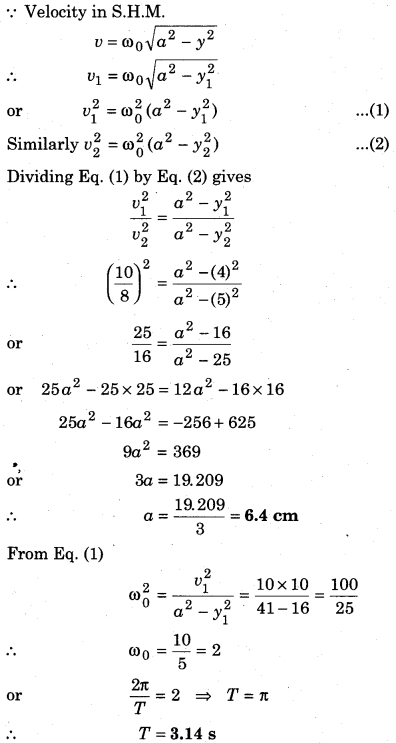
Question 5.
A particle is doing simple harmonic motion. Its maximum velocity is 3 m/s and amplitude of motion is 0.2 m. Calculate the time period of motion.
Solution:
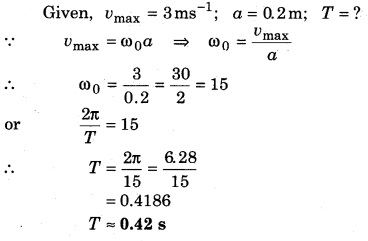
Question 6.
A piece of 1 kg mass is hanged from a spring. The spring constant is 50 N/m. The piece is stretched from the equilibrium position x = 0, t = 0 on a frictional surface to a distance x = 10 cm. The piece is at a distance 5 cm from its mean position. Calculate its kinetic, potential and total energy.
Solution:
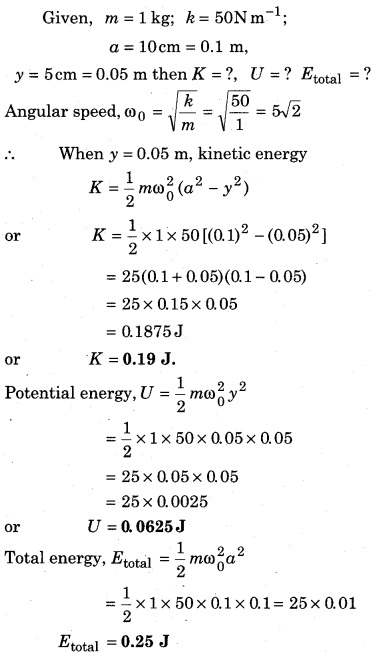
Question 7.
The time period of a simple harmonic oscillator is 6 s. After how much time will the displacement be half of its amplitude if it starts its motion from the equilibrium position?
Solution:

Equation for the displacement of a particle starting motion from equilibrium is
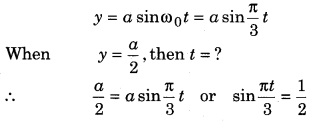

Question 8.
The simple harmonic oscillator has total energy of 9.0 J at any instant with potential energy 5 J. The amplitude is 0.01 m and its mass is 2 kg. Calculate the time period.
Solution:
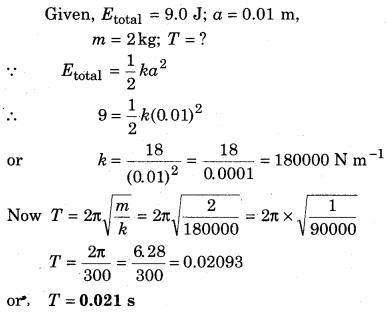
Question 9.
If the gravitational acceleration on Moon is 1/6th times the gravitational acceleration on the Earth. Then how many times will be the time period of the simple pendulum on moon?
Solution:
Given, gm =ge/6; Tm = ?
Time period of the simple pendulum on the Earth

Time period of same simple pendulum on Moon
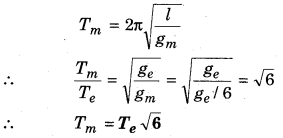
Question 10.
The bob of a simple pendulum has a mass of 0.025 kg. The effective length of the string is 1 m and time period 2.0 s. Calculate the value of gravitational acceleration g.
Solution:
Given, m = 0.025 kg ; l = 1 m; T = 2s;
g = ?
∵ Time period of simple pendulum

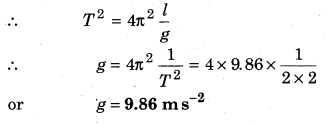
Question 11.
The length of a second pendulum is 1 m [where g = 9.8m/s2]. What will be the length of the second pendulum on any planet where g = 4.9 m/s2 ?
Solution:
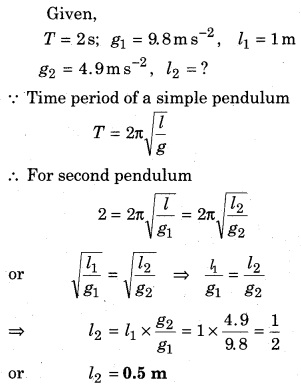
Question 12.
In simple harmonic motion in which position; velocity is half of the maximum velocity?
Solution:
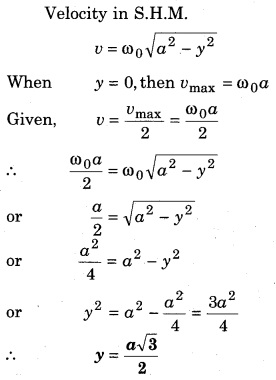
Question 13.
Calculate the percentage change in the time period of a simple pendulum in the following positions;
(i) Increasing the length of the pendulum by 5%.
(ii) Increasing the mass of the pendulum by 5%.
(iii) Increasing the amplitude of the pendulum by 5%.
Solution:
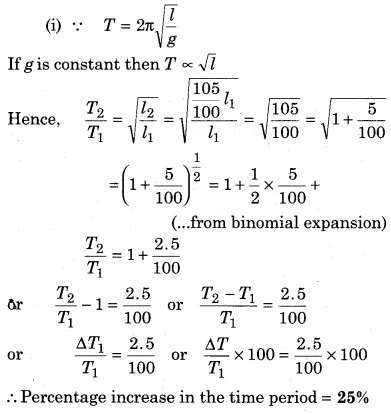

In this formula, m is not there have time period is independent of m.
∴ Even if mass is increased by 5% time period remains unaffected.

Time formula does not have amplitude hence time period will not depend on amplitude.
∴ If amplitude is increased by 5%, the time period remains unaffected.
Question 14.
A body of mass 0.5 kg hanged from an ideal spring is executing vertical oscillation. Oscillation time is π/2 S, then calculate the spring constant.
Solution:
